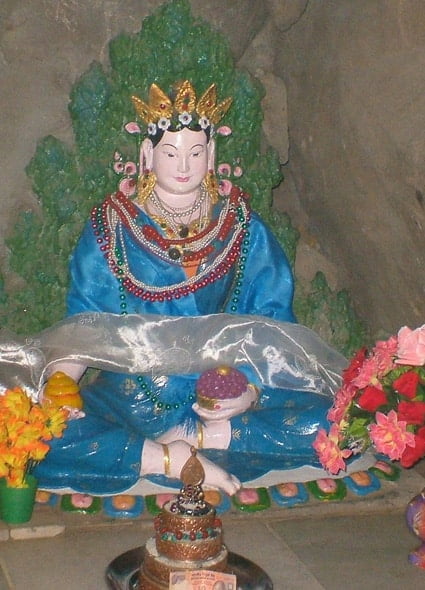Princess Mandarava, according to spiritual biographies, was born into the noble family of Zahor, in northeastern India. Her birth was marked with miraculous signs. Her father was said to be an incarnation of the Buddha’s father Śuddhodana, and her mother was a ḍākinī. Mandārava herself was an incarnation of the Buddha Paṇḍāravāsinī, the consort of Amitābha.
As one of the two principal consorts of the great 8th century Indian Vajrayana teacher Padmasambhava, she was a fully realized spiritual adept, yogini, and spiritual teacher. Her life stories describe her scholarly training and her mastery of languages, poetry, and all the sciences. Under their master Vimalaprajñ, she studied the core principles of Buddhist thought and took the Bodhisattva vow. Moreover, she inspired all her female retinue to enter the Buddhist path. Firmly set on a life of renunciation, she avoided an arranged marriage and took monastic ordination along with her five hundred attendants. Her father, the king, allowed the women to pursue the religious life in a heavily guarded palace.
Padmasambhava, however, was not thwarted by mundane restraints and thus manifested in the palace to instruct Mandarava and her retinue in the Vajrayāna teachings. Hearing of this development, the king was furious. He ordered Mandārava to be imprisoned in a pit and Padmasambhava burned alive. As the flames leapt up, Padmasambhava transformed the would-be funeral pyre into a lake of sesame oil. This was surrounded by a ring of fire in the midst of which bloomed a lotus flower. Padmasambhava sat upon the lotus seat amidst radiant rainbows and clouds. Realizing immediately that Padmasambhava was a manifestation of a Buddha, the king confessed his misdeed and appointed Padmasambhava as king of the land of Zahor. Padmasambhava and Mandarava then taught the dharma to the entire kingdom.
Mandarava attained full enlightenment alongside Padmasambhava in the famed Maratika Cave in Nepal. Together there they received, practiced, and accomplished the Chime Soktik, a terma received directly from Buddha Amitayus who they met face-to-face. This terma is the central long-life practice of the Dudjom Tersar lineage.
A number of terma namtar of Mandarava were revealed beginning in the twelfth century. In the seventeenth century, the tertön Samten Lingpa revealed a terma which has been translated into English as The Lives and Liberation of Princess Mandarava.
ཡིད་འཕྲོག་པདྨ་རཱ་གའི་མཚར་སྡུག་ཅན། །
yitrok pema ragé tsar dukchen
You are a mesmerizing beauty, like a lotus ruby.སྲིད་དང་ཞི་བ་དབྱེར་མེད་འཛུམ་ཞལ་ལ། །
si dang zhiwa yermé dzum zhel la
Your smile displays the unity of existence and peace.རྣམ་ཐར་གསུམ་གྱི་སྤྱན་རས་རབ་གཡོ་བས། །
namtar sum gyi chen ré rap yowé
Your flashing eyes reveal the three liberations.འགྲོ་ཀུན་འཁོར་བ་སྒྲོལ་མཛད་ཁྱོད་ལ་བསྟོད། །
From Music to Delight the Ḍākinī: A Praise to the Deathless Mandāravā by Jamyang Khyentse Wangpo.
dro kün khorwa dröl dzé khyö la tö
You free all beings from samsara: I offer you praise!
Whoever sees, hears, recalls, or encounters this biography will be placed on the path to perfect enlightenment. This account will include: her lifestory in seven paradises, the manner in which she intentionally manifested herself for the benefit of beings, how she entered the womb of her mother with the power of the fivefold state of clairvoyance, how she became disillusioned with samsara, how she practiced the six perfections and trained on the stages of the path, how she developed qualities through her practice of secret mantra, her accomplishment of the state of an immortal pure awareness holder, her attainment of enlightenment, her passage into nirvana, and the manner in which she intentionally reincarnated herself for the benefit of others. In all, there will be thirteen divisions.
The Benefits of Reading the Spiritual Biography from The Lives and Liberation of Princess Mandarava.



